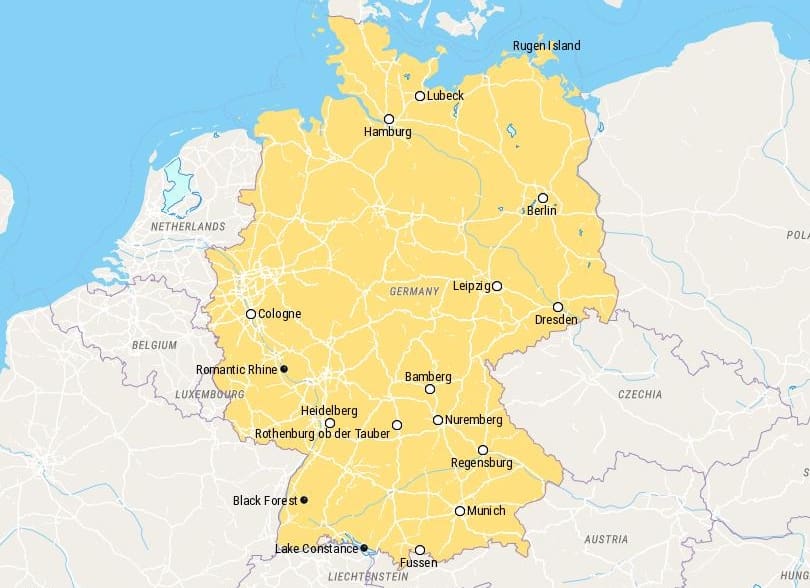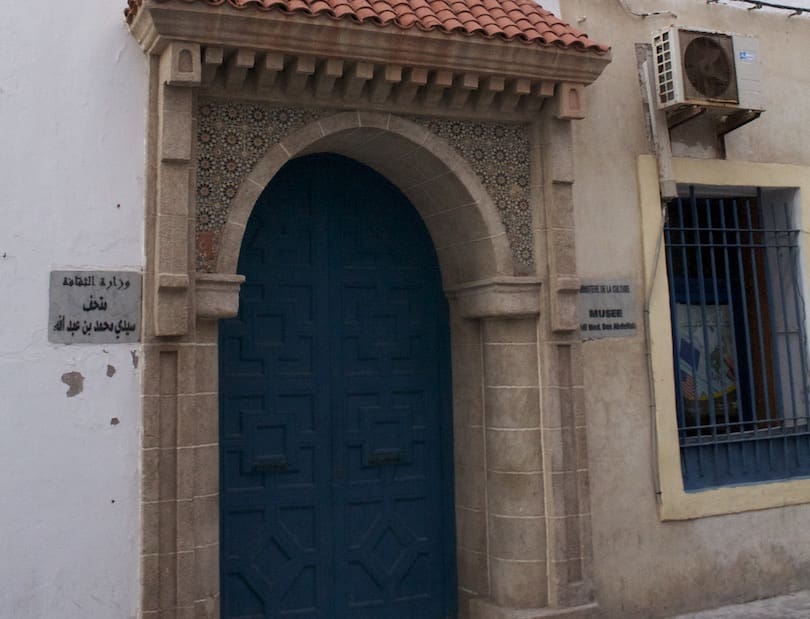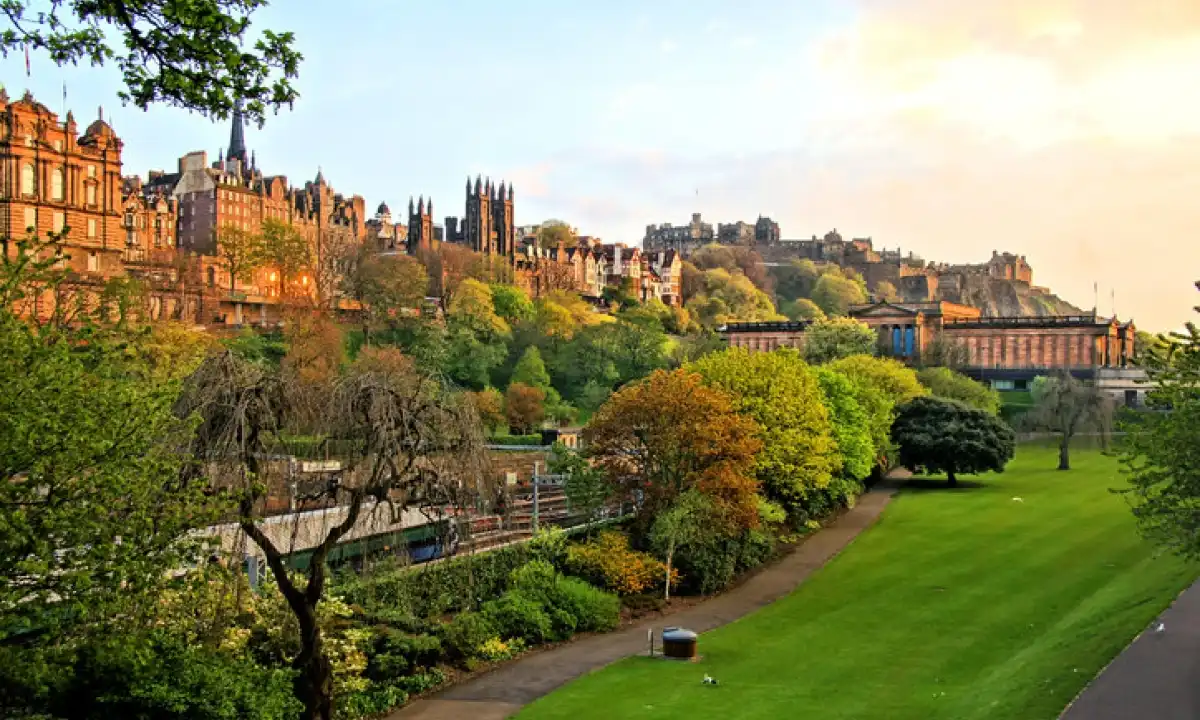Germany, a country rich in history, culture, and natural beauty, offers a plethora of destinations for travelers to explore. From vibrant cities to picturesque landscapes, Germany has something to offer every type of traveler. Whether you’re interested in history, architecture, or outdoor adventures, this article presents the 17 best places to visit in Germany. So, let’s embark on a journey to discover the gems of this fascinating country.
1. Berlin
Overview
Berlin, the capital of Germany, is a vibrant and cosmopolitan city with a rich history. It serves as a testament to the country’s resilience and progress. The city seamlessly blends its past with modern architecture, art, and culture.
Brandenburg Gate
The iconic Brandenburg Gate is one of Berlin’s most famous landmarks. This neoclassical monument symbolizes the reunification of East and West Germany. Visitors can marvel at its grandeur and learn about its historical significance.
Berlin Wall
A visit to Berlin would be incomplete without experiencing the remnants of the Berlin Wall. This historic barrier once divided the city, and today, visitors can explore the East Side Gallery, a stretch of the wall adorned with colorful murals by renowned artists.
Museum Island
Museum Island is a UNESCO World Heritage site and home to five world-class museums. Art enthusiasts can admire ancient treasures, classical sculptures, and renowned works by artists such as Van Gogh and Monet.
2. Munich
Overview
Munich, the capital of Bavaria, is known for its traditional charm, stunning architecture, and vibrant beer gardens. It seamlessly combines history with a modern lifestyle, offering a unique experience for visitors.
Marienplatz
Marienplatz is the heart of Munich and a bustling square surrounded by stunning architecture. The famous Glockenspiel, located in the New Town Hall, delights visitors with its chimes and animated figurines.
Neuschwanstein Castle
Perched atop a hill, Neuschwanstein Castle is a fairytale-like masterpiece and one of Germany’s most iconic landmarks. Visitors can tour its opulent interiors and marvel at the breathtaking views of the surrounding Bavarian countryside.
Oktoberfest
Munich is famous for hosting the world’s largest beer festival, Oktoberfest. This lively event attracts millions of visitors each year who gather to enjoy traditional Bavarian beer, food, and music.
3. Hamburg
Overview
Hamburg, the second-largest city in Germany, is a bustling metropolis known for its maritime history and vibrant cultural scene. It offers a unique blend of historic charm and modern attractions.
Miniatur Wunderland
Miniatur Wunderland is a fascinating attraction for all ages. It features the world’s largest model railway, showcasing intricate miniature landscapes, cities, and even an airport. Visitors can marvel at the attention to detail and immerse themselves in this miniature world.
Port of Hamburg
As a major port city, Hamburg’s harbor is a sight to behold. Visitors can take a boat tour to explore the bustling port, admire the massive container ships, and enjoy stunning views of the Elbe River.
Speicherstadt
Speicherstadt, the historic warehouse district, is a UNESCO World Heritage site. Its red-brick buildings and narrow canals create a picturesque setting. Visitors can explore its charming streets, visit museums, and indulge in delicious coffee and cake at one of the traditional cafés.
4. Cologne
Overview
Cologne, located on the banks of the Rhine River, is a city renowned for its stunning cathedral, vibrant carnival celebrations, and rich cultural heritage.
Cologne Cathedral
Cologne Cathedral, a UNESCO World Heritage site, is an architectural marvel and one of the largest Gothic cathedrals in the world. Visitors can admire its intricate details, climb the tower for panoramic views, and learn about its fascinating history.
Museum Ludwig
Art enthusiasts will appreciate the Museum Ludwig, which houses an impressive collection of modern and contemporary art. From Picasso to Warhol, the museum showcases a diverse range of artworks.
Hohenzollern Bridge
The Hohenzollern Bridge is not only a vital transportation link but also a romantic symbol of love. Couples attach padlocks to the bridge’s railings, symbolizing their everlasting love. Visitors can enjoy a leisurely stroll across the bridge while taking in the picturesque views of the city and the Rhine River.
5. Frankfurt
Overview
Frankfurt, the financial hub of Germany, is a modern city characterized by its towering skyscrapers, historic sites, and bustling markets.
Romer
Romer is Frankfurt’s historic town hall and a symbol of the city’s medieval past. The complex consists of several beautifully restored buildings with stunning facades. Visitors can explore the Romer Square and soak in the charming atmosphere.
Palmengarten
Palmengarten is a botanical garden that offers a peaceful retreat from the city’s hustle and bustle. With a vast collection of plant species from around the world, visitors can stroll through lush greenery, admire vibrant flowers, and relax in tranquil surroundings.
Main Tower
The Main Tower is Frankfurt’s tallest skyscraper and provides panoramic views of the cityscape. Visitors can take an elevator to the observation deck and enjoy breathtaking vistas of the Frankfurt skyline.
6. Heidelberg
Overview
Heidelberg is a picturesque city nestled in the Neckar River Valley. It is famous for its well-preserved castle, romantic atmosphere, and one of Europe’s oldest universities.
Heidelberg Castle
Heidelberg Castle stands majestically above the city, offering panoramic views and a glimpse into the past. Visitors can explore the castle’s ruins, wander through its beautiful gardens, and learn about its fascinating history.
Old Bridge
The Old Bridge, also known as Karl Theodor Bridge, is a charming pedestrian bridge spanning the Neckar River. Visitors can take a leisurely stroll across the bridge, capturing stunning views of the castle and the city.
Philosophers’ Walk
The Philosophers’ Walk is a scenic path on the northern side of the Neckar River. It offers breathtaking views of Heidelberg’s old town, castle, and the surrounding landscape. Visitors can enjoy a peaceful walk and embrace the serenity of nature.
7. Dresden
Overview
Dresden, often referred to as the “Florence on the Elbe,” is a city renowned for its stunning architecture, world-class museums, and rich cultural heritage.
Zwinger Palace
Zwinger Palace is a Baroque masterpiece and a must-visit attraction in Dresden. Its ornate architecture, beautiful gardens, and impressive art collections make it a cultural gem.
Semperoper
Semperoper, Dresden’s famous opera house, showcases world-class performances. Visitors can enjoy opera, ballet, or classical music concerts in this magnificent venue that has hosted renowned artists throughout history.
Frauenkirche
The Frauenkirche, a symbol of peace and reconciliation, is a breathtaking Baroque church. Destroyed during World War II, it has been meticulously reconstructed and now stands as a testament to the city’s resilience.
8. Nuremberg
Overview
Nuremberg, a city with a rich medieval history, is famous for its well-preserved old town, historic landmarks, and delicious gingerbread.
Nuremberg Castle
Nuremberg Castle dominates the city’s skyline and offers panoramic views from its towers. Visitors can explore the castle complex, including the Imperial Castle, and delve into the city’s medieval past.
Documentation Center
The Documentation Center at the Nazi Party Rally Grounds provides insight into the city’s role during the Nazi era. Through informative exhibits and multimedia presentations, visitors can gain a deeper understanding of this dark period in history.
Albrecht Durer’s House
Art enthusiasts will appreciate a visit to Albrecht Durer’s House, the former residence of the famous German Renaissance artist. It showcases Durer’s works, personal artifacts, and provides a glimpse into his life and artistic achievements.
9. Rothenburg ob der Tauber
Overview
Rothenburg ob der Tauber is a picturesque medieval town that seems frozen in time. With its well-preserved city walls, cobblestone streets, and charming half-timbered houses, it’s a true gem of the Romantic Road.
Rothenburg Town Hall
Rothenburg’s Town Hall is a stunning example of Gothic and Renaissance architecture. Visitors can climb the tower for panoramic views of the town and explore the museum housed within the building.
Plonlein
Plonlein, a small square in Rothenburg, is one of the town’s most iconic spots. It features a picturesque half-timbered house flanked by two towers, creating a postcard-perfect scene that is often photographed.
Night Watchman Tour
Taking a Night Watchman Tour is a unique way to explore Rothenburg. The entertaining guide dressed as a medieval night watchman leads visitors through the dark streets, sharing stories and legends from the town’s history.
10. The Romantic Road
Overview
The Romantic Road is a scenic route that winds through picturesque landscapes, charming towns, and fairytale castles. It offers a quintessential German experience, showcasing the country’s natural beauty and cultural heritage.
Würzburg
Würzburg, the starting point of the Romantic Road, is known for its stunning Residenz Palace. Visitors can explore the palace’s opulent interiors and stroll through the charming streets of the old town.
Dinkelsbühl
Dinkelsbühl is a well-preserved medieval town with colorful half-timbered houses and cobblestone streets. Visitors can wander through the town’s charming squares, visit historic churches, and soak in its medieval atmosphere.
Füssen
Füssen is the gateway to the fairytale-like Neuschwanstein Castle. Apart from visiting the castle, visitors can explore Füssen’s charming old town, enjoy scenic walks, and experience Bavarian hospitality.
11. The Black Forest
Overview
The Black Forest, located in southwestern Germany, is a region famous for its dense forests, picturesque villages, and cuckoo clocks. It offers opportunities for outdoor activities, scenic drives, and immersing oneself in nature.
Triberg Waterfalls
Triberg Waterfalls, the highest waterfalls in Germany, cascade through the lush greenery of the Black Forest. Visitors can hike along well-maintained paths, breathe in the fresh air, and marvel at the beauty of nature.
Lake Titisee
Lake Titisee, a crystal-clear lake nestled in the heart of the Black Forest, is a popular destination for water sports and relaxation. Visitors can take a boat ride, go swimming, or simply unwind on the lake’s shores.
Baden-Baden
Baden-Baden is a spa town known for its thermal baths, luxurious resorts, and elegant architecture. Visitors can indulge in wellness treatments, explore the town’s beautiful parks and gardens, or try their luck at the renowned Baden-Baden Casino.
12. The Rhine Valley
Overview
The Rhine Valley is a scenic region renowned for its charming vineyards, medieval castles, and the majestic Rhine River. It offers breathtaking views, wine tasting experiences, and picturesque towns along the riverbanks.
Lorelei Rock
Lorelei Rock is a legendary cliff on the Rhine River that captivates visitors with its beauty and folklore. According to legend, a siren lured sailors to their demise with her enchanting song. Visitors can admire the panoramic views from the viewpoint and listen to the captivating tales.
Rhine River Cruise
A Rhine River cruise is a fantastic way to explore the region. Visitors can relax on a boat, enjoy stunning landscapes, pass by picturesque villages, and marvel at the castles perched on hilltops along the way.
Marksburg Castle
Marksburg Castle, perched on a hill overlooking the Rhine River, is one of the best-preserved medieval castles in Germany. Visitors can take a guided tour to learn about its history, explore its courtyards and towers, and enjoy panoramic views of the Rhine Valley.
13. Neuschwanstein Castle
Overview
Neuschwanstein Castle, located in the Bavarian Alps, is a fairytale-like castle that inspired Disney’s Sleeping Beauty Castle. It is a must-visit destination, enchanting visitors with its picturesque setting and romantic architecture.
History
Built by King Ludwig II in the 19th century, Neuschwanstein Castle was intended as a personal retreat and homage to Richard Wagner, the famous composer. However, the castle was never completed as Ludwig’s death halted construction.
Architecture
Neuschwanstein Castle showcases a unique blend of Romanesque and Gothic Revival architectural styles. Its soaring towers, turrets, and ornate interiors make it a true architectural marvel.
Interior
Visitors can tour a selection of rooms inside the castle, including the King’s Bedroom, the Throne Room, and the Singer’s Hall. The interiors are opulently decorated with intricate woodcarvings, murals, and lavish furnishings.
14. Berlin
Overview
Berlin, the capital of Germany, is a vibrant and dynamic city with a rich history, world-class museums, and a thriving arts scene. It is a melting pot of cultures and offers something for everyone.
Brandenburg Gate
The Brandenburg Gate is an iconic symbol of Berlin and a historic landmark. Visitors can walk through the gate, capturing the city’s vibrant atmosphere and enjoying the view of the Unter den Linden boulevard.
Berlin Wall Memorial
The Berlin Wall Memorial is a powerful reminder of the city’s divided past. Visitors can explore the preserved sections of the wall, learn about the history of the Cold War, and reflect on the importance of unity and freedom.
Museum Island
Museum Island is a UNESCO World Heritage site and home to several world-renowned museums. Visitors can explore the Pergamon Museum, the Neues Museum, and the Alte Nationalgalerie, among others, to delve into art, history, and culture.
15. The Baltic Sea Coast
Overview
The Baltic Sea Coast offers pristine beaches, charming seaside towns, and picturesque landscapes. It is a perfect destination for relaxation, water activities, and exploring the unique coastal culture.
Rügen Island
Rügen Island is the largest island in Germany and a popular summer getaway. Visitors can relax on sandy beaches, explore the Jasmund National Park with its famous chalk cliffs, or visit the charming seaside resort town of Binz.
Stralsund
Stralsund, a UNESCO World Heritage site, is a medieval town located on the Baltic Sea coast. Visitors can admire its beautifully preserved architecture, visit the Gothic brick churches, and explore the historic old town.
Usedom Island
Usedom Island is known for its stunning sandy beaches, wellness resorts, and beautiful nature. Visitors can enjoy long walks along the coast, indulge in spa treatments, and explore the island’s charming towns and villages.
Conclusion
Germany offers a wealth of diverse and captivating destinations that cater to all interests. Whether you’re a history buff, an art enthusiast, a nature lover, or simply seeking a memorable experience, Germany has something for everyone. From the vibrant streets of Berlin to the fairytale castles of Bavaria, each place has its own unique charm and allure. Explore the bustling cities, immerse yourself in history, indulge in delicious cuisine, and embrace the warm hospitality of the German people. Plan your visit to Germany and embark on a journey that will leave you with unforgettable memories.
FAQs
- Is Germany a safe country to visit?
Germany is generally considered a safe country for tourists. However, it’s always advisable to take common safety precautions and be aware of your surroundings, especially in crowded tourist areas.
- What is the best time to visit Germany?
The best time to visit Germany depends on your preferences and the region you plan to explore. Summer months (June to August) offer pleasant weather and are ideal for outdoor activities. Spring and autumn are also good times to visit, with milder temperatures and fewer crowds. Winter is perfect for experiencing Germany’s famous Christmas markets and winter sports in the Bavarian Alps.
- Do I need a visa to visit Germany?
The visa requirements for Germany vary depending on your nationality. Citizens of the European Union and several other countries do not require a visa for short-term visits. It’s best to check with the German embassy or consulate in your home country for the most up-to-date visa information.
- Can I travel within Germany using public transportation?
Germany has an excellent public transportation system, including trains, buses, and trams. It’s easy to travel between cities and towns using public transportation, and it’s a convenient and eco-friendly option for exploring the country.
- What are some traditional German dishes I should try?
Germany is known for its hearty and delicious cuisine. Some traditional dishes to try include bratwurst (grilled sausage), sauerkraut (fermented cabbage), pretzels, schnitzel (breaded meat cutlets), and Black Forest cake (chocolate cake with cherries and cream).














